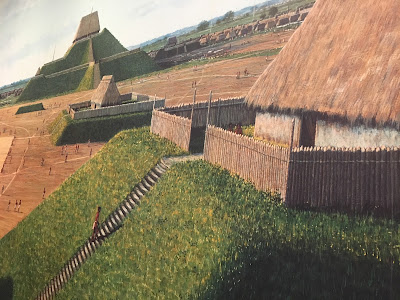I was particularly interested to get back to the section about Cahokia, which is now present day in Illinois just down the highway from where I grew up in Edwardsville and practically in the shadow of the St. Louis Arch (see these photos from my most recent visit to Cahokia).
I would have liked Mann to include more about Cahokia. But he colors in a bit of the amazing story of the Cahokia tribe of the Illiniwek people. Here are some of his highlights:- Anyone traveling up the Mississippi River in 1180 would’ve seen the 120 "Cahokia mounds" looming in the distance.
- Monks Mound was (and still is) the largest of the mounds and is the largest man-made mound ever built in the United States. Its base is larger than both the Pyramid of the Sun in Mexico and the Great Pyramid of Giza in Egypt.
- With about 15,000 people, Cahokia was the largest concentration of people north of the Rio Grande. It was also really the only city - period - north of the Rio Grande. The population at the time was comparable in size to London, which, if you think about it, is kind of astounding.
- It had few specialized craft workers and no middle-class merchants. The inhabitants really knew nothing about how cities worked so they had to invent everything for themselves as they progressed.
- Much at the heart of Mann's thesis is that Cahokia's mounds weren’t always thought to be Native American. In the 19th century, various scholars believed them to be Chinese, Welsh, Phoenician, or others. In fact, there was very little serious study at all about Cahokia until the 1960s.
- Since then, there has been a flood and we have learned a lot, including the 270 bodies that have been found, with all of the burials occurring between 1000 and 1200, including overwhelming evidence of sacrifical burials. Mann notes that about 50 women appear to have been buried alive.
- What eventually killed Cahokia's earliest society was the agricultural runoff created by their maize production, which got into Cahokia Creek and other waterways nearby. Cahokia's leaders were so focused on keeping a strong hold over their people that they didn’t pay enough attention to external environmental factors.
- By 1350, there was almost no one left. Never again would be that large of a Native American community be established north of Mexico.


No comments:
Post a Comment